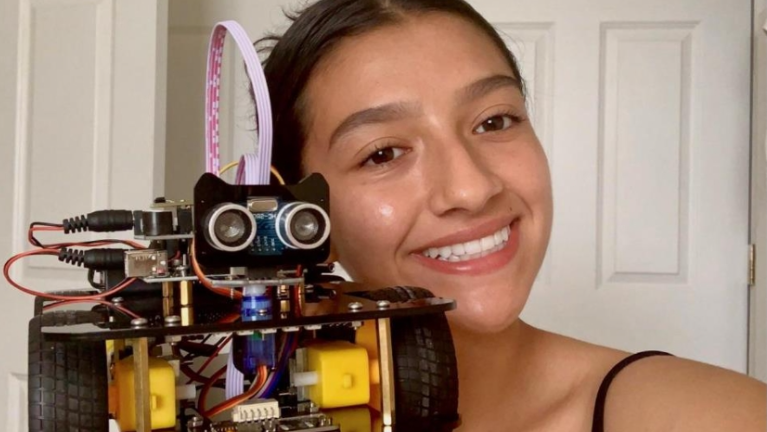NASA MAA Program Motivates Stem Students

By Nazrul Khandaker
Allowing urban K1-12 students access to NASA STEM education-related resources and available relevant best practices is becoming an effective pathway to augment STEM outreach initiatives of the MUREP Aerospace Academy (aka MAA), housed in York College (City University of New York). The free NASA MAA Program was introduced to the community in 2015 to increase STEM awareness, train, engage, and motivate students from the community. This community is traditionally known to represent underserved and financially disadvantaged groups. It succeeded the previous NASA
Program known as the Science, Engineering, Mathematics and Aerospace Academy (aka SEMAA). Between SEMAA and MAA, York has already served over 28,000 students since its inception in 1999. In terms of demographic distribution, African American students always led the bulk of the attending students, followed by Asian and Hispanic representations. Many students who participated in the program went on to complete STEM majors, including several who earned PhDs in STEM fields.
Since mid-March 2020, the York College MAA Program took the necessary steps to become virtual due to the COVID-19 pandemic, and successfully operated by serving a larger group of K1-12 underrepresented and underserved students. Being virtual, the program does not restrict out of state or even overseas participation, and an increased number of students - particularly in the high school group - are now taking advantage of this offering. A notable aspect of the program is the involvement of the parents and caregivers through the Family Focus Group (FFG). FFG meets regularly during the operation of the program and acts as a primary source of conveying STEM resources and increasing awareness to citizens, which ably helps in recruiting students.
Enrollment in high school classes dramatically increased from 6% before COVID-19 to 25% during the pandemic. Recently concluded fall 2020 virtual session ended with 20% enrollments. This is remarkable, and certainly testifies to the notion that students’ continued participation throughout the year in STEM-related after school programs can foster their affinity towards STEM subjects and build their knowledge base to become college ready. It also helped retain students, reach others, and promote additional recruitment. A few students who participated in the summer program have already received an acceptance to begin their undergraduate education in STEM fields in fall 2021. Students communicated with the MAA staff and were very appreciative of the experiential knowledge gained through the York’s NASA MAA program, and how it outweighed their candidacy and favored their eventual selections to the undergraduate program.
The very successful NASA MAA program at York College of the City University of New York was strongly supported by NASA, and augmented by AT&T and Con Edison. Particularly, funding from AT&T strictly emphasized the need to offer peer mentoring of urban high school students during the summer and potential expansion during regular fall and spring sessions. AT&T’s support was pivotal to enable representative high school students from the borough of Queens, New York (one of the most diverse counties in the nation) to receive the necessary STEM kits to conduct experiments from their home setting with ease. To comply with social distancing policy, students visited York campus with their parents based on a schedule agreed prior to coming to the campus. Students collected
STEM kits from the MAA staff, and the same protocols were followed when they returned the STEM kits back to the MAA staff.
Knowledge of basic python language, coupled with rocketry and aerodynamics, assisted home-based high school students to accomplish tasks. The summer 2020 program offered an afternoon session in addition to the morning session, to augment students’ learning and prepared a cohort of 40 high school students to engage in STEM research. Several past NASA program participants, now gainfully employed in STEM professions, offered assistance to take part in virtual mentoring and joined hands with MAA to broaden the scope of mentoring tasks.
Matthew Khargie (past NASA participant, Senior Analyst at CoEnterprise and STEM Voice for Minorities at NASA MAA) led the external peer mentoring, and brought a new dimension to the program. His involvement allowed participating high school students to receive the most updated technical information related to electronics, computer sciences, data management, artificial intelligence, and an overall preparation needed to be competitive in college admissions and seek future employment in a technology field.
The outcome of the 2020 summer program during COVID-19 was highly encouraging, as it built a trained cohort of 40 students who eventually participated in a virtual STEM conference led by the Geological Society of America (GSA). Both student-led and co- authored poster presentations were made, and presenting students received very good feedback from the session organizers.
York’s NASA MAA is continuing its peer mentoring initiative, and the goal is to increase the scope and allow additional students to receive research training during the 2021 spring and 2021 summer. Furthermore, NASA’s newly developed Artemis Mission-related lessons are getting priorities in terms dissemination of additional curriculum enhancement activities and training to the students.
It is hoped that student-led or co-authored posters will be presented at the GSA’s 2021 Annual Meeting, to be held in Portland, Oregon. Both written posters and brief audio recordings are available on The Geological Society of America Website.
Please visit the York NASA MAA Program website.

